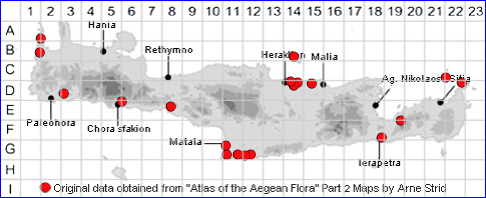
SPECIES DESCRIPTION
CAMPANULA CREUTZBURGII
Family:- CAMPANULACEAE
Common Names:- None
Synonyms:- Campanula drabifolia subsp. creutzburgii.
Meaning:- Campanula (L) Bell-like.
Creutzburgii (L) After Nikolaus Creutzburg. German geographer.
General description:- Annual with with stiff bristly hairs or with sharp stiff hairs
lying close to the surface (hispid-strigose).
Stems:-
a) sparingly branched from the base.
b) with procumbent branches.
Leaves:-
1) Lamina:
a) dentate, oblong.
b) basal shortly stalked (petiolate).
c) cauline small, hairless (sessile), more deeply dentate.
Flowers:-
a) with short stems (pedicellate).
1) Bracts:
a) entire or with one pair of indistinct basal teeth.
2) Calyx:
a) hispid; sinus between the calyx-teeth acute; star-shaped and spreading and
increasing in length or thickness with age in fruit.
3) Corolla:
a) 7-10 mm.
b) narrowly tubular-bell-shaped (campanulate).
c) blue.
Fruit:-
1) Capsule:
a) pendent.
Key features:-
1) Corolla c. 7-10 mm.
2) Calyx without appendages between the teeth. Stellate-patent and accrescent in
fruit.
Habitat:- Rock ledges, rocky and stony places in dry open shrubby vegetation
generally on limestone near the coast. 0-200 m.
Distribution:- Endemic to Crete, limited distribution around coastal areas. Rare
Flowering time:- Mar-May.
Photos by:- Marinos Gogolos
Status:-
Conservation status (for threatened species): Rare (R) according to IUCN 1997.
Protection status (for threatened species): Greek Presidential Decree 67/1981.
